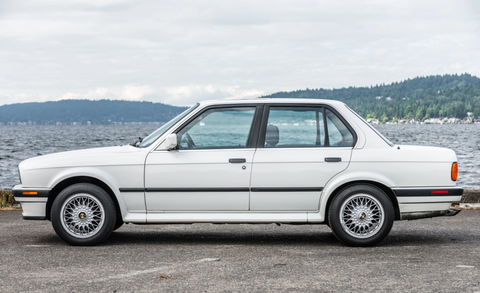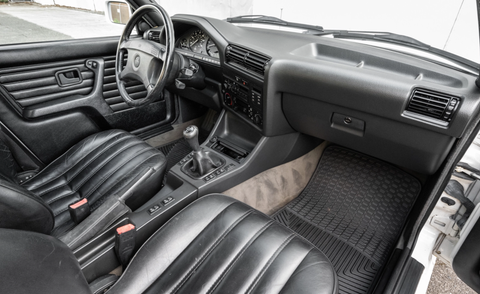• This 1991 BMW 325iX is one of very few seemingly rust-free examples we’ve seen in a long time.
• All-wheel-drive E30s haven’t leapt in price the same way rear-wheel-drive variants have, and they’re more practical, too.
• This clean example is for sale right now on Bring a Trailer, and the auction ends on April 11.
For some time now, the word has been out about BMW’s E30-generation 3-series, sold in the U.S. from 1984 to 1991, with prices steadily on the climb. Unmolested examples are hard to find, and it’s harder still to find a solid example of the much rarer all-wheel-drive version, which was sold in the U.S. from 1988 to 1991, the tail of the E30’s run. Despite commanding a $4400 premium when new, they tend to be cheaper than RWD cars in the used market.
Why? Simple: You’d daily-drive any BMW 325, but you’d daily-drive an iX through anything—which is exactly why most 325ix cars currently for sale are pretty well weatherbeaten. Many were sold in the Northeast, where there’s lots of snow to be conquered, and the iX was an absolute monster at doing just that. Issue is, a lot of snow means a lot of road salt. And a lot of road salt means a lot of corrosion. This one escapes that, having spent its life in Seattle, Washington, since new. It got wet but not salty.
Leaning into the increased capability afforded by the all-wheel-drive system, the iX rode 0.8 inch higher than the regular 325, and thanks to its fender flares it was about a half an inch wider, too. There might be nothing that proves the effectiveness of that AWD system better than this video, shot at a tank proving ground (we’d really love to see a modern 330i xDrive pull off the same stunt).
The system was simple in principle: a transfer case mounted aft of the transmission used a viscous LSD to distribute power between front and rear wheels, with a nominal 37/63 bias standard (at the time BMW cared about retaining its rear-wheel-drive character). Torque distribution could vary between 10 and 100 percent as wheel slippage occurred. Another coupling worked the same way from right to left in the rear differential.
Those couplings wear out over time, and at the time of this writing, commenters are currently awaiting proof of this one’s function. Otherwise, this 325iX has had a bunch of recent work done that’s said to include brakes, alternator, driveshaft, U-joints, and flex discs. That’s on top of a few inoffensive modifications that are well advised, like stainless brake lines and an upgraded shift mechanism.
On top of that, 1991 was the last year of production, and it’s a five-speed. Over 31 years, 96,000 miles just isn’t a lot, especially considering the number that have more like 200,000 today. It does seem there may have been some front-end damage in the past, though nothing appears in the Carfax. And there are some scuffs and dings here and there, but maybe they’ll serve to keep the final price manageable . . . which is more important when you’re buying something that’s less of a collectible and more of something you’ll want to use without guilt. And if you do, you’ve got until Monday, April 11, to place your bid.
This content is created and maintained by a third party, and imported onto this page to help users provide their email addresses. You may be able to find more information about this and similar content at piano.io




